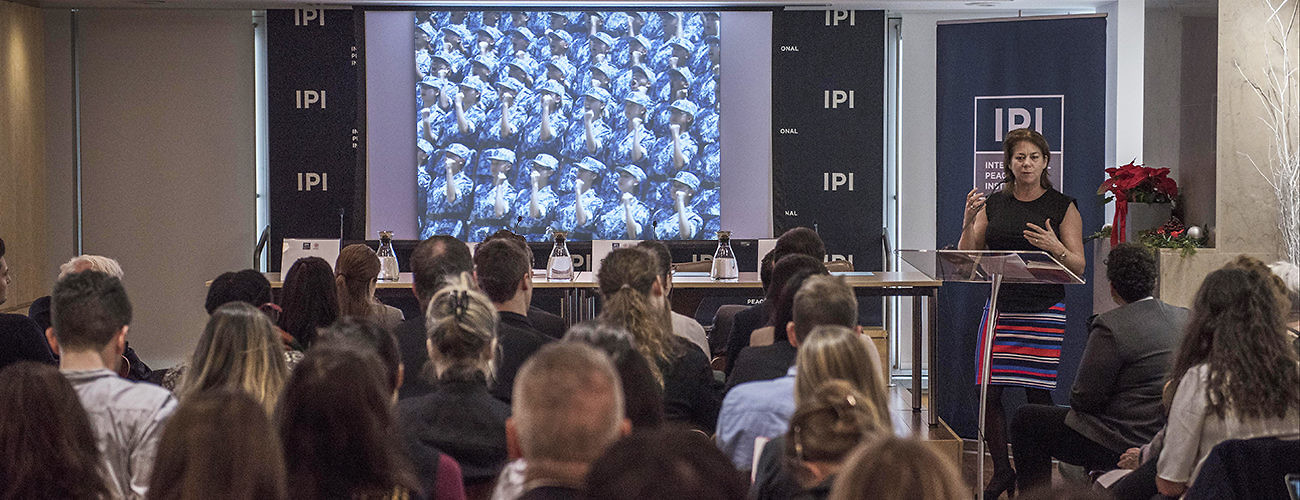How are humanitarian workers able to achieve meaningful engagement with armed groups at a time when they are multiplying, fragmenting, unstructured, and fighting in coalitions of state- and non-state armed groups?
These conflict scenarios informed a November 30th IPI policy forum co-hosted with the International Committee of the Red Cross (ICRC). While showcasing the ICRC report, “The Roots of Restraint in War,” panelists discussed ways in which we can better understand how interaction with armed actors can encourage their compliance with the norms of international humanitarian law and thus protect civilians and help prevent human suffering.
IPI Vice President and moderator Adam Lupel introduced the panel noting that “we are seeing a multiplication and fracturing of armed groups, as well as a tendency for conflicts to be fought in coalitions of states and in groupings of state- and non-state armed actors.” In these complex conflicts, he said, “violence against civilians and a lack of respect for international humanitarian law continues on an all-too regular basis.”
In these irregular settings, the work of humanitarian aid organizations has become increasingly challenging, Robert Mardini, Permanent Observer to the United Nations and head of Delegation in New York at the ICRC, said. He cited a statistic that more armed groups have emerged in the past seven years than in the past seven decades. “In Taiz, Yemen, there were 39 different armed groups interacting in fluid alliances,” he said.
Fighting among armed groups and state coalitions affects 50 million people in cities around the world, according to Mr. Mardini, and to alleviate their suffering, the ICRC is working on influencing belligerents to comply with the laws of war as well as helping communities cope with the consequences of conflict. He asserted that the work of humanitarian players can effectively influence fighters and soldiers on the ground, and that in order for it to do so, it is “important to unpack and understand what determines the restraint in war,” rather than solely the causes of violence.
Fiona Terry, who authored the ICRC report, “The Roots of Restraint in War,” discussed the importance of socialization and the role that training can play. The study focused on how norms are adopted within a group and how training can determine those norms, but also added that informal norms can sometimes posit more powerful restraints than formal ones. “We could find evidence that training has made a difference on behavior,” she explained.
She told an anecdote of the Kodok hospital in South Sudan which remained untouched when its surrounding ICRC compound was looted. “Despite the rhetoric of uncontrolled violence, armed groups’ commanders have more control than they let on, and they don’t want to let us know so that they can abdicate responsibility,” she said.
In analyzing the roots of restraint, she noted that they varied depending on the armed group. “The more decentralized the group is, the more porous it is to outside groups,” she said, because in decentralized groups, “there are more actors with influence but the percentage of influence is diminished.”
Overall the evidence proved that “training has an influence on behavior, training has to be intense, and the nature of the trainer is important.” Furthermore, she pointed out that “Non-State Armed Groups’ ideology plays an equally, and in some cases, more important role; holding them to ideology is the best way to influence them.” Dr. Terry concluded that through this research, “We are able to influence behavior, criminalizing activity.”
Sergiusz Sidorowicz, Policy and Planning Officer, Disarmament, Demobilization, and Reintegration (DDR) Section, UN Department of Peacekeeping Operations, echoed Dr. Terry’s analysis on the importance of distinguishing between armed groups. “Non-state conflict and non-state actors have been rising,” he said, “yet analytical tools at our disposal often lump all non-state actors in a single category, but the truth is they are diverse and with different agendas, and they require a broader toolbox.”
He gave a brief typology of the four different tiers of armed groups present in the Central African Republic—those with national agendas, those who take part in criminal activity, localized economic predators, and historic groups active in inter-criminal violence.
Humanitarian workers’ dialogue and interaction with these diffuse armed groups had grown more difficult and time consuming, said Sophie Solomon, Access Adviser in the Policy Advice and Planning Section of the UN Office for the Coordination of Humanitarian Affairs. “Certain ideologies are not conducive to dialogue,” she said, and “require time and resources to engage on a daily basis to make significant progress”
Humanitarian work had been hindered as well by the development of counterterrorism policies that had undermined humanitarian access, and had had a chilling effect on humanitarian activities, including creating a fear of penalization for humanitarian service. Counterterrorism measures have led to a “blurring of lines between the political and humanitarian agendas” she stated.
She concluded that encouraging compliance with the norms of international humanitarian law requires a better understanding of the environment of context-specific conflict and a coordinated, sustainable approach. “Engaging with armed forces is a long-term investment,” she said, “and dialogue is needed with armed actors not only in times of crisis.”








